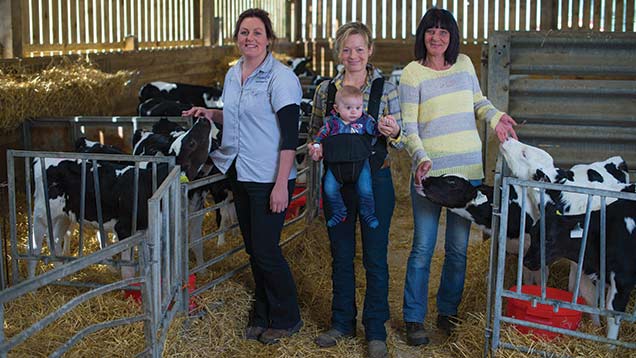Block-calving ‘lite’ programme improves fertility and health
 Emma Martin (centre) with vet Sarah Caldwell (left) and calf-rearer Jane Hick. ©Jim Wileman
Emma Martin (centre) with vet Sarah Caldwell (left) and calf-rearer Jane Hick. ©Jim Wileman Switching to a three-month on, three-month off block calving system has helped improve cow fertility and calf health at Trethick Farm, St Mabyn, Cornwall.
Previously the 1,000-cow herd calved round the clock, but owner Emma Martin says it was making work life hectic.
“We were constantly calving, AI’ing, drying off and having vet pregnancy checks with no break.
“Also, our replacement heifers were born throughout the year, which made the management of vaccinations and service times difficult compared with the two heifer blocks we now have,” explains Ms Martin, who farms alongside her parents Donna and Tim, and brother Richard.
See also: How a year-round calving herd has improved submission rates
Consequently they decided to re-evaluate their breeding programme and adopted a block calving “lite” approach on the advice of their local practice Calweton Veterinary Group.
Dry cow diet
- 18kg maize
- 8kg whole crop
- 3kg silage
- 5kg chopped straw
- 2kg milking cow blend
- 1kg regumaize
- 200g magnesium chloride
- 100g feed grade urea
- 100g dry cow minerals
“We can’t block-calve 1,000 cows. We haven’t got the facilities and we need a consistent milk supply, because we sell to Dairy Crest and they want a relatively level profile,” explains Ms Martin, who says running a block-calving lite system is a “happy medium” between block and year-round calving.
She says having a more structured approach to breeding has made staffing much easier because everyone can focus on one job, while simultaneously offering them the flexibility to roll cows over into the next three-month breeding period, she adds.
Since the switch, submission rates have improved from 53% to 62% and pregnancy rates have increased from 16% to 24%.
Vet Miranda Macinnes from Calweton Veterinary Group says: “The improvement in submission rates is not unexpected.
“In block calving herds, cows’ oestrus behaviour is less subtle – more cows will be bulling at the same time and this group effect makes heat expression more apparent. Therefore silent heats are less likely and more cows will get served.
“In addition, the minds of those watching for bulling behaviour can be more focused,” says Ms Martin, who adds that because cows are allowed to rest for longer they are more fertile.
“When we were year-round calving we used to start serving cows at 40 days [post calving]. Now all cows pretty much have one cycle.”
Fertility improvements
Cows are dried off 56 days before calving and moved to a second unit until they calve down. They are kept in cubicles on sawdust-bedded mattresses until one week before calving, when they move into loose straw housing.
They receive post-natal checks 18 days after calving. A combination of heat time collars and visual observations are used to detect heats.
About 90% of the cows are served to high-fertility Holstein bulls, the remainder, including the heifers, are naturally served to a beef bull.
Cows are then PD’d at 38 days post service, providing they haven’t returned to service.
“During the service period vets come in twice a week to look at non-bullers, do PDs and carry out post-natal checks,” says Ms Martin.
Calf health
Calf rearer Jane Hick says the move has also enhanced calf health due to improved biosecurity and cleanliness.
Statistics show calf mortality has been slashed by 82% (see figures, left) and antibiotic use has tumbled by two-thirds.
Calves receive four to six litres of colostrum within 12 hours of birth and are kept in pens of five. The herd is monitored for BVD using the tag-and-test system and all calves are tagged at birth to identify PIs.
At one week of age they move into pens of 15 and are fed milk powder twice a day. This is reduced to once-a-day feeding at four weeks.
Farm facts
Trethick Farm, St Mabyn, Cornwall
- Supply milk to Dairy Crest
- At their peak they are milking 1,020 cows, yielding 8,400 litres a cow a year at 3.3% protein and 4.25% fat
- Cows are milked through a 50/50 herringbone parlour
- Aim to calve heifers at two years of age
- Only pregnant cows are grazed
“Usually we start thinking about weaning them at nine weeks, depending on how many pellets they are eating,” says Ms Hick.
The Martin family is considering the use of calf jackets for smaller, weaker heifer calves.
“Calf jackets maximise feed conversion rates allowing for the energy required for warmth to be directed into growth and overall health,” says Vet Sarah Caldwell, from Calweton vets.
Beforehand, all calves were given an oral solution to reduce the shedding of cryptosporidium parvum, which causes scour in young calves.
But through improved cleanliness the farm has completely cut its use.
“The ‘all-in-all-out’ system has definitely reduced mortality rates and drug use, without a doubt. The biggest benefit we have seen is a reduction in scours and pneumonia,” says Ms Hick.
“It has made a great difference having a three-month rest. We can steam-clean and disinfect all the pens after each batch and have a fresh start. We never had that stop period before, where we were able to clean down.”
Ms Caldwell says the improvements were largely borne out of the fact they are not seeing a diverse mix of calf ages kept in the same environment.
“[Crypto] is a protozoal parasite which thrives in damp conditions, therefore having the time to allow the pens to dry out completely is a significant factor in the reduction of disease.”
She adds: “It all comes back to focusing the mind – and doing one job at a time, rather than 10, makes that easier to achieve.”

